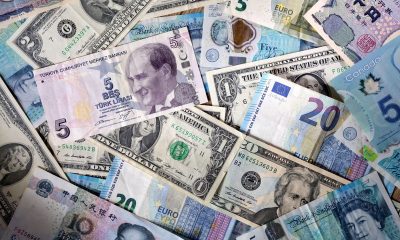Commodities
Energy & precious metals – weekly review and outlook


© Reuters.
Investing.com – Muted inflation data and yet a still-vibrant U.S. economy: Could oil bulls ask for more? Yes: A dynamic Chinese recovery as well.
A flurry of economic data from China in the coming week is expected to show its post-pandemic bounce is quickly fizzling out, raising expectations that the world’s largest oil importer needs to unveil more stimulus measures soon to shore up activity and shaky consumer confidence.
After a strong start to the year following the dismantling of tough COVID-19 measures, recent data have pointed to a sharp loss of economic momentum due to weak demand at home and abroad and a protracted slump in the country’s property market, traditionally a significant growth driver.
That could be the worst challenge now to oil longs who seem to have most of everything they need for that summer rally they had long awaited.
China’s apparent petroleum demand – refinery runs plus net oil product imports – was up 25% and 17% year over year in April and May respectively, according to figures from data provider CEIC. Diesel production in May was 26% higher than a year earlier, and a full 40% higher than in May 2019 before the pandemic hit.
Given how bad things are right now in China’s property sector, that is an astonishing figure. Property investment in May was 21% lower than in May 2022. At the same time, highway transport remains lackluster. Freight turnover is still below late 2019 levels, and highway passenger transport turnover, in person-kilometer terms, is still less than half pre-pandemic levels. Domestic air traffic has recovered more rapidly but, as a portion of China’s total petroleum consumption, jet fuel remains small relative to diesel and gasoline.
The Wall Street Journal last week offered several possible explanations for the phenomenon but concluded that the simplest would be that Chinese refiners and regulators – like much of the world – misjudged both the strength of China’s recovery and the global energy market.
“If you want to sustain this oil rally, you’re going to need the Chinese,” said John Kilduff, partner at New York energy hedge fund Again Capital. “Traditionally, they account for more than 20% of global oil demand.”
“You can’t cut your way to prosperity; that’s my message to OPEC,” added Kilduff. “As much as oil bulls think any loss of demand can be made up with fewer barrels, the comfort level the market takes with demand is always greater. Tight oil is fantastic, if you can maintain it, yes. But you saw what happened after the Ukraine invasion; how quickly we lost that $140 a barrel despite OPEC trying to manage production month after month with cuts.”
Understanding perhaps just that, OPEC’s latest monthly report stated that “continued improvements in China [are] expected to boost consumption of oil”. The oil cartel, however, made no explicit forecasts on Chinese demand.
Customs data from Beijing, meanwhile, showed a different story: Exports plunged 12.4% year-on-year in June – the most in three years – as higher interest rates worldwide dampened demand for Chinese goods.
Some economists have blamed the “scarring effects” caused by years of strict COVID measures and regulatory curbs on the property and technology sectors – despite recent official efforts to reverse some curbs to support the economy.
With uncertainty in China running high, cautious households and private businesses are building up their savings and paying off their debts rather than making new purchases or investments. Youth unemployment has hit record highs.
On the GDP front, China, as the world’s second-largest economy, likely managed growth of just 0.5% in the second quarter compared with three months earlier, on a seasonally adjusted basis, according to a Reuters poll. Compared with a year earlier, GDP may have grown 7.3% in April-June from a year earlier, compared with growth of 4.5% in the first quarter.
Specifically with oil, Chinese refiners – who had already cranked up diesel output in late 2022 for export – might have decided to keep production high in hopes of a property-driven and infrastructure-driven demand boom at home in early 2023.
With still-high state-set fuel prices at home and falling crude prices globally, refiners would also have been in a position to reap some major margins. But the hoped-for demand surge in China has yet to materialize.
The Journal observed that China doesn’t publish petroleum inventory data as regularly as the United States, so it is difficult to say for sure how much diesel might be sitting in storage somewhere.
“At some point, though, refiners might need to capitulate to reality and dial down output, unless the government’s strategic reserve decides to step in,” it said. “When and if that happens, Chinese apparent oil demand could well take a hit, weighing further on global oil prices in late 2023.”
Oil: Market Settlements and Activity
New York-based , or WTI, did a final trade of $77.30 a barrel on Friday. It officially ended the session at $75.27, down $1.62, or 2.1%, posting its first daily loss since the week began. On a weekly basis, the U.S. crude benchmark was up about 2%, extending last week’s 4.6% rally and the prior week’s run-up of 2.1%.
London-traded did a final trade of $79.63 a barrel. It officially settled the session at $79.87, down $1.49, or 1.8% – also booking for its first lower close this week after Thursday’s three-month high of $81.42. For the week, Brent was also up about 2% after last week’s 4.8% rally and the prior week’s 1.4% gain.
“Oil is trading relatively flat today but has made tremendous gains over the last couple of weeks and could still add to that over the coming sessions,” said Craig Erlam, analyst at online trading platform OANDA, noting that prices were up 13% from June 28 lows and may have more to rise.
But while the rally was a victory for the Saudis and their oil-producing allies in the OPEC+ to break beyond $80 a barrel, Erlam cautioned that Brent could face serious resistance at $83-$84, if it continued rising. “A move lower will draw attention back to $80,” he added.
Oil: WTI Technical Outlook
The next major upside target for U.S. crude would be a swing high of $83.50, followed by the 100-week SMA, or Simple Moving Average of $85.10 and the monthly Middle Bollinger Band of $86.20, said Sunil Kumar Dixit, chief technical strategist at SKCharting.com. But he cautioned that the short-term outlook remained fragile, with an initial range-bound price action between $77.30 and $73.70.
“Continuation of last week’s bullish momentum hinges on stability above the weekly middle Bollinger Band of $73.70,” said Dixit. “Further advances will require a strong breakout above the 50-week EMA, or Exponential Moving Average, of $78.50.”
And while WTI’s RSI, or Relative Strength Index, shows support across the daily and weekly time-frames, Daily Stochastics negativity may cause some pullback towards the 100-day SMA of $73.50, below which 50 Day EMA $72.35 may be tested.
Gold: Market Settlements and Activity
“Steady as she goes”: That was this week’s gold market.
Since benign inflation data over the past three days suggested the Federal Reserve might step back sooner than expected from using its rate cudgel, gold has practically tip-toed up – even as other commodities led by oil have blazed higher. , which normally takes its cue from gold, has also left its more lustrous cousin in the shadows with sharp gains this week.
on New York’s Comex did a final trade of $1,959.30 an ounce on Friday after officially settling the session at $1964.40, up just 60 cents on the day. In the previous session it did a little better, rising $2 to strike a three-week high of $1,968.50 from a three-month bottom of $1,900.60 a week ago.
The , which reflects physical trades in bullion and is more closely followed than futures by some traders, settled at $1,955.47, down $5.02, or 0.3%.
“Gold has stalled [at] around $1,960 after surging in the aftermath of the US inflation data earlier this week,” said Erlam of online trading platform OANDA. “Now it’s a question of whether what we’re seeing is a corrective move as part of the downturn since May or if that downturn was in fact the correction.”
Gold’s ever-slow move higher has surprised many, especially after the Labor Department reported on Wednesday that the , or CPI, grew by just 3% year-on-year in June versus a 40-year high of 9.1% a year ago. The , or PPI, which came on the heels of the CPI, was also lower than expected.
Notwithstanding those, the University of Michigan said on Friday its closely-watched Consumer Sentiment survey showed the spending appetite of Americans at its highest in two years, a development economists said wouldn’t be too encouraging for the Fed, which wishes to see a greater retreat in inflation.
All eyes are now on the Fed and what it will do to rates when its policy-makers sit again on July 26 to decide on rates. While the so-called Federal Open Market Committee of the Fed decided to pass on a hike last month, economists think in all likelihood it will vote for a 25-basis point increase this time, in keeping with its recent pace of hikes.
Gold: Price Outlook
This week, the 100-day SMA of $1,953 and the 50-day EMA of $1,945 are likely to act as support areas for spot gold, which if broken, can push prices down towards the $1,938-$1,935 support zone, said SKCharting’s Dixit. “This area is a turning point with risk of deeper correction reaching $1,927-$1,915.
“All things being equal, stability above $1,953-$1,945 will keep chances valid for a resumption of the uptrend which needs a retest of the $1,963-$1,965 horizontal resistance zone, followed by a decisive breakout above, for the next leg higher of $1,975 and the previous month’s high of $1,983.”
Natural gas: Market Settlements and Activity
U.S. natural production neared record highs in the just-ended week while some of the heat that has been baking Texas and other southern U.S. states came off a little, prodding market participants to price the fuel down further towards mid-$2 levels.
Most-active the New York Mercantile Exchange’s Henry Hub did a final trade at $2.548 per mmBtu, or British thermal units, after officially closing the session at $2.539, down six cents.
Just a week earlier, Henry Hub’s front-month contract peaked at around $2.90, marking the loftiest level for a front-month gas contract on the Henry Hub since March.
Natural gas: Price Outlook
Natural gas continues to show momentum distribution below resistance levels as it settles the week below the 5-week EMA for the second time in a row, observed Dixit.
“Going into the week ahead, the 50-day EMA of $2.52 is a fragile support, below which the 100-day SMA of $2.40 and the weekly Middle Bollinger Band of $2.39 are closely aligned support areas that are likely to hold,” he said. In the short-term, the market was likely to remain sideways with range-bound price action.”
“Over an extended period of time, a strong and decisive breakout above the 5-month EMA of $2.75 will promptly retest natural gas’ swing high of $2.84 and psychological handle of $3.00, followed by the 100-month SMA of $3.25,” he said. “Major upside target is a confluence of the 50-week EMA of $3.72 and the 200-week SMA of $3.75.”
Disclaimer: Barani Krishnan does not hold positions in the commodities and securities he writes about.
Commodities
Oil prices rise; U.S. crude inventories plunge, Russia-Ukraine truce eyed
Commodities
India’s Reliance to stop buying Venezuelan oil over US tariffs, sources say
Commodities
Oil prices climb on Venezuela supply worries

 Forex3 years ago
Forex3 years agoForex Today: the dollar is gaining strength amid gloomy sentiment at the start of the Fed’s week

 Forex3 years ago
Forex3 years agoUnbiased review of Pocket Option broker

 Forex3 years ago
Forex3 years agoDollar to pound sterling exchange rate today: Pound plummeted to its lowest since 1985

 Forex3 years ago
Forex3 years agoHow is the Australian dollar doing today?

 Cryptocurrency3 years ago
Cryptocurrency3 years agoWhat happened in the crypto market – current events today

 World3 years ago
World3 years agoWhy are modern video games an art form?

 Commodities3 years ago
Commodities3 years agoCopper continues to fall in price on expectations of lower demand in China

 Economy3 years ago
Economy3 years agoCrude oil tankers double in price due to EU anti-Russian sanctions



























